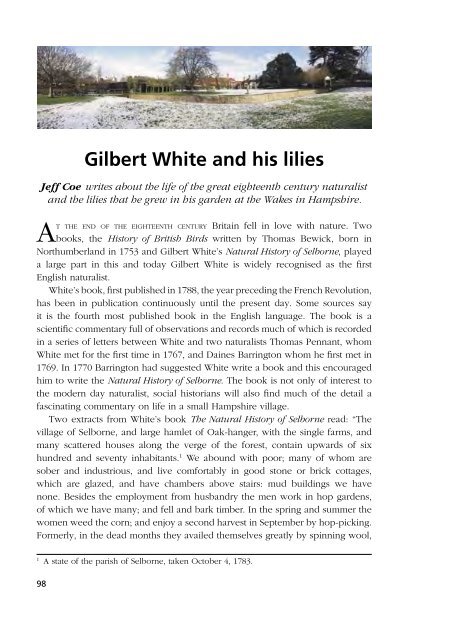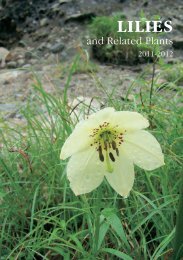LILIES - RHS Lily Group
LILIES - RHS Lily Group
LILIES - RHS Lily Group
You also want an ePaper? Increase the reach of your titles
YUMPU automatically turns print PDFs into web optimized ePapers that Google loves.
98<br />
Gilbert White and his lilies<br />
Jeff Coe writes about the life of the great eighteenth century naturalist<br />
and the lilies that he grew in his garden at the Wakes in Hampshire.<br />
T THE END OF THE EIGHTEENTH CENTURY Britain fell in love with nature. Two<br />
Abooks,<br />
the History of British Birds written by Thomas Bewick, born in<br />
Northumberland in 1753 and Gilbert White’s Natural History of Selborne, played<br />
a large part in this and today Gilbert White is widely recognised as the first<br />
English naturalist.<br />
White’s book, first published in 1788, the year preceding the French Revolution,<br />
has been in publication continuously until the present day. Some sources say<br />
it is the fourth most published book in the English language. The book is a<br />
scientific commentary full of observations and records much of which is recorded<br />
in a series of letters between White and two naturalists Thomas Pennant, whom<br />
White met for the first time in 1767, and Daines Barrington whom he first met in<br />
1769. In 1770 Barrington had suggested White write a book and this encouraged<br />
him to write the Natural History of Selborne. The book is not only of interest to<br />
the modern day naturalist, social historians will also find much of the detail a<br />
fascinating commentary on life in a small Hampshire village.<br />
Two extracts from White’s book The Natural History of Selborne read: “The<br />
village of Selborne, and large hamlet of Oak-hanger, with the single farms, and<br />
many scattered houses along the verge of the forest, contain upwards of six<br />
hundred and seventy inhabitants. 1 We abound with poor; many of whom are<br />
sober and industrious, and live comfortably in good stone or brick cottages,<br />
which are glazed, and have chambers above stairs: mud buildings we have<br />
none. Besides the employment from husbandry the men work in hop gardens,<br />
of which we have many; and fell and bark timber. In the spring and summer the<br />
women weed the corn; and enjoy a second harvest in September by hop-picking.<br />
Formerly, in the dead months they availed themselves greatly by spinning wool,<br />
1 A state of the parish of Selborne, taken October 4, 1783.




